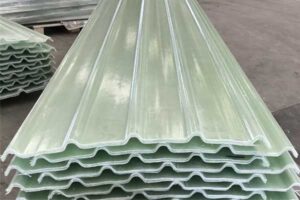What is Fiberglass (FRP) plate?
Fiberglass (FRP) plate is a composite structural material that consists of a polymer matrix reinforced with glass fibers. The polymer matrix is typically made of a thermosetting resin, such as polyester, vinyl ester, or epoxy, while the glass fibers are woven or chopped into a fabric or mat. The combination of these two materials results in a plate that is strong, lightweight, and durable.

Fiberglass (FRP) Plate
Applications of FRP Plate
FRP plate is often used in a variety of applications, including construction, marine, transportation, and industrial. In construction, the FRP plate can be used as a structural component for buildings and bridges, as it has a high strength-to-weight ratio and is resistant to corrosion. In marine applications, it can be used for boat hulls and decks, as it is resistant to saltwater and other marine environments. In transportation, it can be used for truck beds, trailers, and other vehicles, as it is lightweight and durable. In industrial applications, it can be used for tanks, ductwork, and other equipment that is exposed to harsh conditions.
Advantages of FRP Plate
- Corrosion Resistant: Unlike metal, FRP plate is not susceptible to rust or other forms of corrosion, making them ideal for use in environments where the metal can degrade rapidly. Additionally, FRP plate is also resistant to many chemicals, including acids, bases, and solvents, making them suitable for industrial applications.
- High strength-to-weight ratio: FRP is much stronger than traditional materials such as wood or plastic, but also much lighter. This makes it ideal for use in applications where weight is a concern, such as in the transportation industry.
- FRP plates can be manufactured in various thicknesses and sizes, depending on the application. It can also be cut, drilled, or otherwise shaped to meet specific needs. Additionally, it can be painted or coated for added protection or aesthetics.
Overall, the FRP plate is a versatile and durable composite material that has many advantages over traditional materials. Its resistance to corrosion and high strength-to-weight ratio makes it ideal for use in a variety of applications, including construction, marine, transportation, and industrial. Additionally, its ability to be cut, drilled, or shaped to meet specific needs makes it a popular choice for many different projects.

Unicomposite’s FRP Plate System
We supply Various fiberglass plates and decking such as pultruded hollow decking, pultruded open decking, and pultruded multi-leg panels which are well-performed. All Unicomposite’s fiberglass plates and panels are widely used in flooring, seawall, walkways, cooling tower, vehicles, platforms, etc.
 info@unicomposite.com
info@unicomposite.com


























